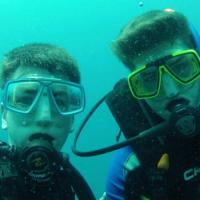This is an interactive map! Use controls to pan and zoom this map.
Access
|
How? By boat
Distance Short boat time (< 10min)
Easy to find? Easy to find
|
|
Dive site Characteristics
Average depth 12 m / 39.4 ft
Max depth 35 m / 114.8 ft
Current Low ( < 1 knot)
Visibility Good ( 10 - 30 m)
Quality
Dive site quality Good
Experience CMAS * / OW
Bio interest Interesting
More details
Week crowd
Week-end crowd
Dive type
- Reef
- Ambiance
Dive site activities
- Marine biology
- Photography
Dangers
Additional Information
English (Translate this text in English): Close Encounters, a long three-sided reef, of which two sides are very good for diving, while the third side of a large sandy slope exists. Two kilometers from the beach, the reef has steep slopes, resulting in a flat up top, which at its deepest point is 12 m and rises up to 3 to 4 m. The slope himself ends in a sandy ground at 25 to 30 m depth. Currents on all house reefs are low to absent, unless we get the bigger tides with shorter intervals. The corals, which cover the entire slope is a good mix of hard and soft corals. Most interesting is probably the eastern side with a lot of angles, corners and crevices, healthy sponges that much protection for the underwater life.
The dive offers typical reef and shoal fish, schools of snappers, large jacks, bat fish, sweet lips, emperor fish and lots of fusiliers, also with a little luck frog fish, crocodile fish, scraps of fish, many different kinds of nudibranchs, scorpion fish and octopus. Occasionally we also see sharks, buffalo head parrot fish and rays.
English (Translate this text in English): Close Encounters, a long three-sided reef, of which two sides are very good for diving, while the third side of a large sandy slope exists. Two kilometers from the beach, the reef has steep slopes, resulting in a flat up top, which at its deepest point is 12 m and rises up to 3 to 4 m. The slope himself ends in a sandy ground at 25 to 30 m depth. Currents on all house reefs are low to absent, unless we get the bigger tides with shorter intervals. The corals, which cover the entire slope is a good mix of hard and soft corals. Most interesting is probably the eastern side with a lot of angles, corners and crevices, healthy sponges that much protection for the underwater life.
The dive offers typical reef and shoal fish, schools of snappers, large jacks, bat fish, sweet lips, emperor fish and lots of fusiliers, also with a little luck frog fish, crocodile fish, scraps of fish, many different kinds of nudibranchs, scorpion fish and octopus. Occasionally we also see sharks, buffalo head parrot fish and rays.
Close Encounters, a long three-sided reef, of which two sides are very good for diving, while the third side of a large sandy slope exists. Two kilometers from the beach, the reef has steep slopes, resulting in a flat up top, which at its deepest point is 12 m and rises up to 3 to 4 m. The slope himself ends in a sandy ground at 25 to 30 m depth. Currents on all house reefs are low to absent, unless we get the bigger tides with shorter intervals. The corals, which cover the entire slope is a good mix of hard and soft corals. Most interesting is probably the eastern side with a lot of angles, corners and crevices, healthy sponges that much protection for the underwater life.
The dive offers typical reef and shoal fish, schools of snappers, large jacks, bat fish, sweet lips, emperor fish and lots of fusiliers, also with a little luck frog fish, crocodile fish, scraps of fish, many different kinds of nudibranchs, scorpion fish and octopus. Occasionally we also see sharks, buffalo head parrot fish and rays.
English (Translate this text in English): Close Encounters, a long three-sided reef, of which two sides are very good for diving, while the third side of a large sandy slope exists. Two kilometers from the beach, the reef has steep slopes, resulting in a flat up top, which at its deepest point is 12 m and rises up to 3 to 4 m. The slope himself ends in a sandy ground at 25 to 30 m depth. Currents on all house reefs are low to absent, unless we get the bigger tides with shorter intervals. The corals, which cover the entire slope is a good mix of hard and soft corals. Most interesting is probably the eastern side with a lot of angles, corners and crevices, healthy sponges that much protection for the underwater life.
The dive offers typical reef and shoal fish, schools of snappers, large jacks, bat fish, sweet lips, emperor fish and lots of fusiliers, also with a little luck frog fish, crocodile fish, scraps of fish, many different kinds of nudibranchs, scorpion fish and octopus. Occasionally we also see sharks, buffalo head parrot fish and rays.
English (Translate this text in English): Close Encounters, a long three-sided reef, of which two sides are very good for diving, while the third side of a large sandy slope exists. Two kilometers from the beach, the reef has steep slopes, resulting in a flat up top, which at its deepest point is 12 m and rises up to 3 to 4 m. The slope himself ends in a sandy ground at 25 to 30 m depth. Currents on all house reefs are low to absent, unless we get the bigger tides with shorter intervals. The corals, which cover the entire slope is a good mix of hard and soft corals. Most interesting is probably the eastern side with a lot of angles, corners and crevices, healthy sponges that much protection for the underwater life.
The dive offers typical reef and shoal fish, schools of snappers, large jacks, bat fish, sweet lips, emperor fish and lots of fusiliers, also with a little luck frog fish, crocodile fish, scraps of fish, many different kinds of nudibranchs, scorpion fish and octopus. Occasionally we also see sharks, buffalo head parrot fish and rays.
English (Translate this text in English): Close Encounters, a long three-sided reef, of which two sides are very good for diving, while the third side of a large sandy slope exists. Two kilometers from the beach, the reef has steep slopes, resulting in a flat up top, which at its deepest point is 12 m and rises up to 3 to 4 m. The slope himself ends in a sandy ground at 25 to 30 m depth. Currents on all house reefs are low to absent, unless we get the bigger tides with shorter intervals. The corals, which cover the entire slope is a good mix of hard and soft corals. Most interesting is probably the eastern side with a lot of angles, corners and crevices, healthy sponges that much protection for the underwater life.
The dive offers typical reef and shoal fish, schools of snappers, large jacks, bat fish, sweet lips, emperor fish and lots of fusiliers, also with a little luck frog fish, crocodile fish, scraps of fish, many different kinds of nudibranchs, scorpion fish and octopus. Occasionally we also see sharks, buffalo head parrot fish and rays.
English (Translate this text in English): Close Encounters, a long three-sided reef, of which two sides are very good for diving, while the third side of a large sandy slope exists. Two kilometers from the beach, the reef has steep slopes, resulting in a flat up top, which at its deepest point is 12 m and rises up to 3 to 4 m. The slope himself ends in a sandy ground at 25 to 30 m depth. Currents on all house reefs are low to absent, unless we get the bigger tides with shorter intervals. The corals, which cover the entire slope is a good mix of hard and soft corals. Most interesting is probably the eastern side with a lot of angles, corners and crevices, healthy sponges that much protection for the underwater life.
The dive offers typical reef and shoal fish, schools of snappers, large jacks, bat fish, sweet lips, emperor fish and lots of fusiliers, also with a little luck frog fish, crocodile fish, scraps of fish, many different kinds of nudibranchs, scorpion fish and octopus. Occasionally we also see sharks, buffalo head parrot fish and rays.
English (Translate this text in English): Close Encounters, a long three-sided reef, of which two sides are very good for diving, while the third side of a large sandy slope exists. Two kilometers from the beach, the reef has steep slopes, resulting in a flat up top, which at its deepest point is 12 m and rises up to 3 to 4 m. The slope himself ends in a sandy ground at 25 to 30 m depth. Currents on all house reefs are low to absent, unless we get the bigger tides with shorter intervals. The corals, which cover the entire slope is a good mix of hard and soft corals. Most interesting is probably the eastern side with a lot of angles, corners and crevices, healthy sponges that much protection for the underwater life.
The dive offers typical reef and shoal fish, schools of snappers, large jacks, bat fish, sweet lips, emperor fish and lots of fusiliers, also with a little luck frog fish, crocodile fish, scraps of fish, many different kinds of nudibranchs, scorpion fish and octopus. Occasionally we also see sharks, buffalo head parrot fish and rays.
English (Translate this text in English): Close Encounters, a long three-sided reef, of which two sides are very good for diving, while the third side of a large sandy slope exists. Two kilometers from the beach, the reef has steep slopes, resulting in a flat up top, which at its deepest point is 12 m and rises up to 3 to 4 m. The slope himself ends in a sandy ground at 25 to 30 m depth. Currents on all house reefs are low to absent, unless we get the bigger tides with shorter intervals. The corals, which cover the entire slope is a good mix of hard and soft corals. Most interesting is probably the eastern side with a lot of angles, corners and crevices, healthy sponges that much protection for the underwater life.
The dive offers typical reef and shoal fish, schools of snappers, large jacks, bat fish, sweet lips, emperor fish and lots of fusiliers, also with a little luck frog fish, crocodile fish, scraps of fish, many different kinds of nudibranchs, scorpion fish and octopus. Occasionally we also see sharks, buffalo head parrot fish and rays.
 Dive logs
Dive logs
Show all (4)...

|
By
Dive 54 Close Encounters - White tipped shark
Niclas, Wyan
More... |

|
By
Close encounters - Wall and sandy bottom. Healthy reeftop. School of bumphead parrotfish, a very big grouper. Harlequin shrimp, hairy crabs & lobster.
More... |
|
 Dive trips
Dive trips
Show all (3)...

|
Trip: bali
By
familie mooris en coremans
More... |

|
Trip: Bali
By
Off-season experiences in Bunutan, Tulamben and Pemuteran
December isn't recommended as top diving season in Bali by most dive guides because of the rainy season. It is true that the run-off from land caused by heavy tropical rains can effect
More... |
|
 Comments
Comments
Please login to use this tool.
No account yet? Register first; it's free!
Show all (0)...
Be the first to comment this country
Errors, Feedback
You can edit this page to correct errors or add new information. If you have any problems regarding this page, Send us feedback.
 Close Encounters
Close Encounters Photos
Photos Dive logs
Dive logs Dive trips
Dive trips Comments
Comments




